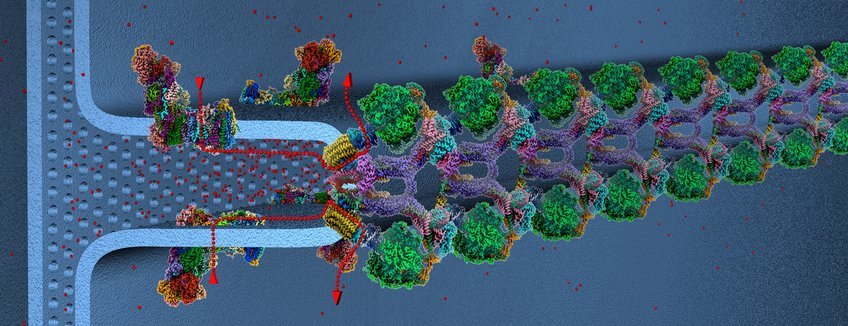
Respiratory Chain Complexes
Project Group of Structural Biology Department
< go back to other projects
Our cryoET studies of mitochondrial membranes have established that the ATP synthase is not randomly distributed in the membrane, as had been generally assumed, but that it segregates laterally into membrane regions that do, and others that do not, contain the ATP synthase. It was therefore interesting to investigate the arrangement and distribution of respiratory chain complexes that generate the proton gradient, which drives ATP production. Already more than 10 years ago we initiated a study of the respirasome, a supramolecular assembly of complexes I, III and IV in the mitochondrial respiratory chain. We isolated the bovine respirasome and examined its structure in negative stain (Schäfer et al., Biochemistry 2007) and by cryoEM (Althoff et al., EMBO J 2011). The resolution achieved at the time was around 20-30 Å. After the introduction of direct electron detectors, we re-initiated the project to determine the structure of the respirasome at high resolution by single-particle cryoEM.
The bovine respirasome
Our recent map of the bovine respirasome at 9 Å resolution indicated defined protein-protein contacts between complex I, III and IV in the hydrophobic membrane interior and at the membrane surface. The main contacts are mediated by supernumerary subunits of complex I. Of the two Rieske iron-sulfur cluster domains in the complex III dimer, only one was resolved, indicating that this domain is immobile and hence unable to transfer electrons. Therefore the complex III monomer it interacts with is inactive, whereas the other FeS domain is not resolved, therefore mobile and the corresponding monomer is active. The central position of the active complex III monomer between complex I and IV is optimal for accepting reduced quinol from complex I over a short diffusion distance of 11 nm, and delivering reduced cytochrome c to complex IV. The functional asymmetry of complex III provides strong evidence for directed electron flow from complex I to complex IV through the active complex III monomer in the mammalian respirasome (Sousa Simoes et al., eLife 2016).
Our original cryoEM study of the bovine supercomplex (Althoff et al., EMBO J 2011) was the first application of amphipols to solubilize membrane protein complexes for single-particle cryoEM. Since then, other groups have adopted this approach very successfully for their high-resolution cryoEM work on membrane protein complexes (see Cao et al., Nature 2013; Bai et al., Nature 2015).
